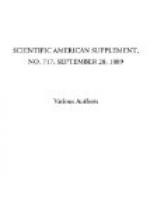The abaca is produced from the fibrous parts of the bark of the wild banana tree, found in the Philippines. Its botanical denomination is Musa troglodytarum. The abaca fiber is not spun or wrung, but is jointed end to end. The threads are wound and subsequently beaten for softening, and finally bleached by plunging in lime water for twenty-four hours, and dried in the sun.
The pina is a fiber obtained from the leaf of the anana tree (Bromelias ananas), and is prepared in the same way as the abaca, but extreme care must in this case be observed in culling the fibers, in order to sort in accordance with their degree of fineness.
The Arabs manufacture the stuff for their tents with a mixture of camel’s hair and the fibrous flocks (kind of wadding) obtained from the stalks of the wafer palm (the Chamaerops humilis).
The tissues used by the Arabs are coarse and colored, but the palm fibers—when freed from gluten, which makes them adhere more strongly—are susceptible to divide in a most astonishing manner.
The Agave americana is a coarse fiber, mostly used in France for the manufacture of Gobelin carpets and the production of ropes. Great efforts have been made to bleach it in a satisfactory manner, as is done with the Phormium tenax, but the former kind of fiber resists the ordinary treatment with lyes, etc., and an appropriate bleaching process has only been discovered quite recently.
Jute, which by many is confounded with Phormium tenax, or New Zealand lint, is a fiber which can be divided as finely as desired, and can be most beautifully bleached.
The jute or Indian paat is generally known as a fibrous and textile fabric, obtained chiefly from Calcutta, and is similar in nature to the Corchorus capsularis, an Oriental species, known in Oriental India by the name of hatta jute and gheenatlapaat. This fibrous plant has the property of dividing into the finest parallel fibers, which can be carded without difficulty, and may be said to have the excellent properties of linen, hemp, and cotton at once. When properly bleached, it has an aspect which is as beautiful as that of silk. A mixture of silk and jute can be easily worked together, and can also be mixed with such vegetable fibers as cotton and linen. An immense quantity of flannel and other stuffs are now manufactured and imitated with the different mixtures containing jute.




